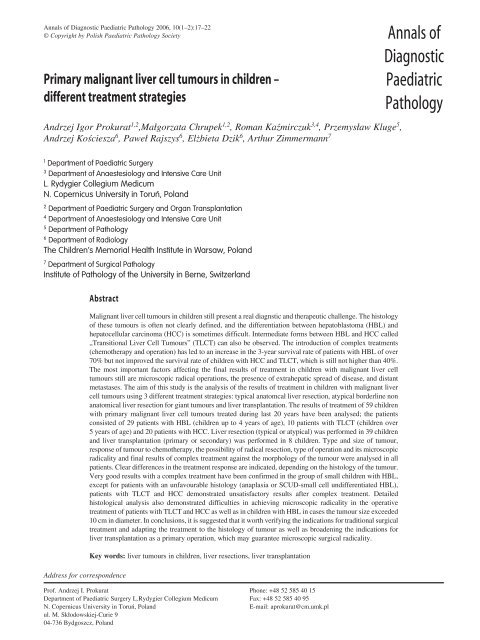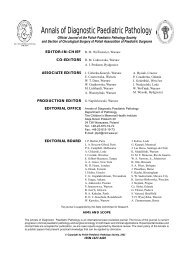annals 1-2.qxd - Centrum Zdrowia Dziecka
annals 1-2.qxd - Centrum Zdrowia Dziecka
annals 1-2.qxd - Centrum Zdrowia Dziecka
You also want an ePaper? Increase the reach of your titles
YUMPU automatically turns print PDFs into web optimized ePapers that Google loves.
Annals of Diagnostic Paediatric Pathology 2006, 10(1–2):17–22<br />
© Copyright by Polish Paediatric Pathology Society Annals of<br />
Primary malignant liver cell tumours in children –<br />
different treatment strategies<br />
Andrzej Igor Prokurat 1,2 ,Ma³gorzata Chrupek 1,2 , Roman KaŸmirczuk 3,4 , Przemys³aw Kluge 5 ,<br />
Andrzej Koœciesza 6 , Pawe³ Rajszys 6 , El¿bieta Dzik 6 , Arthur Zimmermann 7<br />
Diagnostic<br />
Paediatric<br />
Pathology<br />
1<br />
Department of Paediatric Surgery<br />
3<br />
Department of Anaestesiology and Intensive Care Unit<br />
L. Rydygier Collegium Medicum<br />
N. Copernicus University in Toruń, Poland<br />
2<br />
Department of Paediatric Surgery and Organ Transplantation<br />
4<br />
Department of Anaestesiology and Intensive Care Unit<br />
5<br />
Department of Pathology<br />
6<br />
Department of Radiology<br />
The Children's Memorial Health Institute in Warsaw, Poland<br />
7<br />
Department of Surgical Pathology<br />
Institute of Pathology of the University in Berne, Switzerland<br />
Abstract<br />
Address for correspondence<br />
Malignant liver cell tumours in children still present a real diagnstic and therapeutic challenge. The histology<br />
of these tumours is often not clearly defined, and the differentiation between hepatoblastoma (HBL) and<br />
hepatocellular carcinoma (HCC) is sometimes difficult. Intermediate forms between HBL and HCC called<br />
„Transitional Liver Cell Tumours” (TLCT) can also be observed. The introduction of complex treatments<br />
(chemotherapy and operation) has led to an increase in the 3-year survival rate of patients with HBL of over<br />
70% but not improved the survival rate of children with HCC and TLCT, which is still not higher than 40%.<br />
The most important factors affecting the final results of treatment in children with malignant liver cell<br />
tumours still are microscopic radical operations, the presence of extrahepatic spread of disease, and distant<br />
metastases. The aim of this study is the analysis of the results of treatment in children with malignant liver<br />
cell tumours using 3 different treatment strategies: typical anatomcal liver resection, atypical borderline non<br />
anatomical liver resection for giant tumours and liver transplantation. The results of treatment of 59 children<br />
with primary malignant liver cell tumours treated during last 20 years have been analysed; the patients<br />
consisted of 29 patients with HBL (children up to 4 years of age), 10 patients with TLCT (children over<br />
5 years of age) and 20 patients with HCC. Liver resection (typical or atypical) was performed in 39 children<br />
and liver transplantation (primary or secondary) was performed in 8 children. Type and size of tumour,<br />
response of tumour to chemotherapy, the possibility of radical resection, type of operation and its microscopic<br />
radicality and final results of complex treatment against the morphology of the tumour were analysed in all<br />
patients. Clear differences in the treatment response are indicated, depending on the histology of the tumour.<br />
Very good results with a complex treatment have been confirmed in the group of small children with HBL,<br />
except for patients with an unfavourable histology (anaplasia or SCUD-small cell undifferentiated HBL),<br />
patients with TLCT and HCC demonstrated unsatisfactory results after complex treatment. Detailed<br />
histological analysis also demonstrated difficulties in achieving microscopic radicality in the operative<br />
treatment of patients with TLCT and HCC as well as in children with HBL in cases the tumour size exceeded<br />
10 cm in diameter. In conclusions, it is suggested that it worth verifying the indications for traditional surgical<br />
treatment and adapting the treatment to the histology of tumour as well as broadening the indications for<br />
liver transplantation as a primary operation, which may guarantee microscopic surgical radicality.<br />
Key words: liver tumours in children, liver resections, liver transplantation<br />
Prof. Andrzej I. Prokurat Phone: +48 52 585 40 15<br />
Department of Paediatric Surgery L.Rydygier Collegium Medicum Fax: +48 52 585 40 95<br />
N. Copernicus University in Toruñ, Poland E-mail: aprokurat@cm.umk.pl<br />
ul. M. Sk³odowskiej-Curie 9<br />
04-736 Bydgoszcz, Poland

















